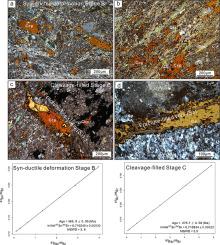Ore Geology Reviews ( IF 3.2 ) Pub Date : 2021-05-13 , DOI: 10.1016/j.oregeorev.2021.104226 Tao Hong , Pete Hollings , Ming-Guo Zhai , Yin-Xi Wang , Xing-Wang Xu , Jun Gao , Yue-Jun Wang

|
The Yulekenhalasu porphyry Cu–Mo deposit is located ca. 40 km southwest of Qinghe, in the Chinese Altay-East Junggar section of the Central Asian Orogenic Belt, NW China. The belt preserves multistage tectonic-hydrothermal and porphyry Cu-Mo mineralization events associated with arc to syn- and post-collision environments over 87 m.y. The 359 Ma deformed granitic porphyries are characterized by positive εNd(t) (+0.62 to + 3.77) and (87Sr/86Sr)initial values (0.704304–0.705960), and old crustal model ages of 747 to 1216 Ma, whereas a 272 Ma sample from late chalcopyrite–molybdenite–pyrite–magnetite–feldspar–calcite–gypsum veins yielded (87Sr/86Sr)initial values of 0.704415 to 0.705764, high εNd(t) values (+5.81 to + 5.88) and young crustal model ages (715 to 614 Ma) suggesting an increasingly juvenile mantle source over time. Seven fragments of a single deformed chalcopyrite grain yielded an Rb-Sr isochron age of 358.6 ± 4.8 Ma (2σ, MSWD = 1.8), which is consistent with the 360 Ma recrystallized zircon grains in the deformed host granitic porphyries. Eight fragments of chalcopyrite from the chalcopyrite–molybdenite–pyrite–magnetite–feldspar–calcite–gypsum veins formed along cleavage planes yielded a younger Rb-Sr isochron age of 272.2 ± 2.6 Ma (2σ, MSWD = 1.8). The younger age is interpreted as the lower age limit for the Mo and Cu mineralization in the post-collisional stage. The heterogeneous initial Sr isotopic compositions of chalcopyrite in the Yulekenhalasu deposit are likely the result of phyllosilicate inclusions. Disseminated chalcopyrite crystals in the granitic porphyry have different trace elemental contents than chalcopyrite in the deformed granitic porphyry and late chalcopyrite veins. Our Rb-Sr and trace element data for chalcopyrite grains constrain the age and geochemistry of multistage mineralization in porphyry Cu-Mo deposits. In-situ S isotope data of chalcopyrite from the deformed granite porphyries and chalcopyrite-feldspar-quartz-muscovite veins display a similar mantle origin. The 272 Ma mineralization event at Yulekenhalasu is coeval with the formation age of the Cu-Ni-(PGE) sulfide deposit in the Chinese Altay, indicating that hydrothermal mineralization like that in porphyry deposits can form proximal to ultramafic–mafic rocks and potentially may have a genetic relationship with mantle-derived Cu-Ni-(PGE) sulfide deposits.











































 京公网安备 11010802027423号
京公网安备 11010802027423号